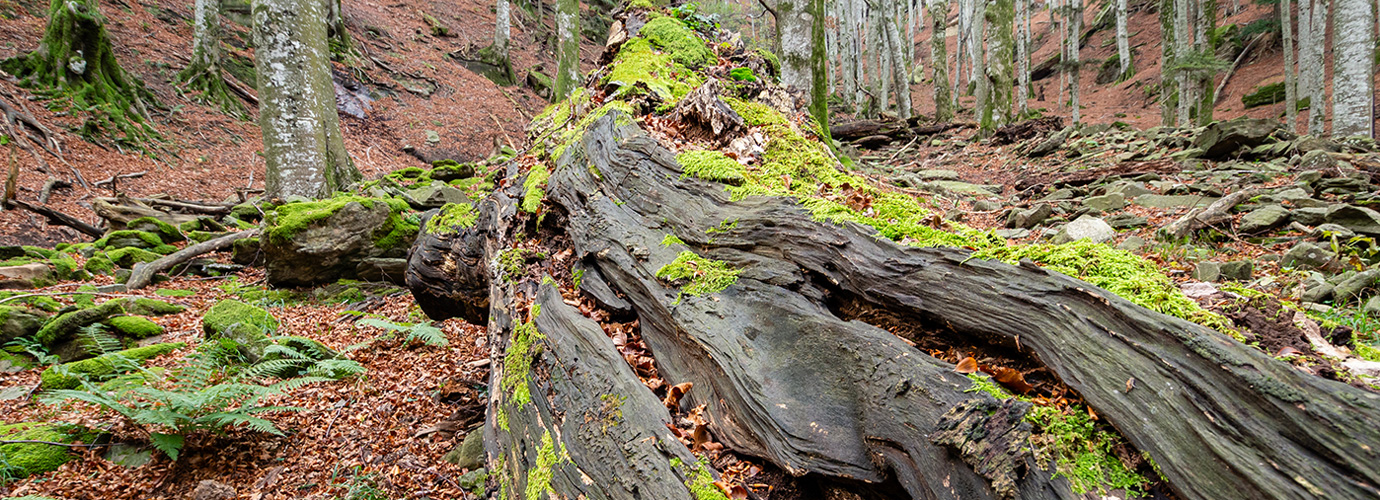News archive
In the occasion of the International Forest Day 2024 the Sherwood's Editorial Board presented a Closer to Nature Forestry ManifestoCloser to Nature Forestry Manifesto, addressed to all those working in the forestry and environmental sector, to promote better management of Italy's forests.
The document has already been signed by 21 Associations and Institutions in the sector, and it is now open for dialogue and discussion with the aim of drafting an even more shared version.
The Mediterranean Model Forest Network decided to sign and promote the Manifesto as the proposed actions and topics match the principles that guide the Model Forests in their approach to participatory governance and sustainable forest and landscape management.
The Manifesto, originally in Italian, was translated in English to spread it through the Network, as we think it can be an inspiration for other Mediterranean countries. Here below the full text.

Closer to Nature Forestry Manifesto
Against the backdrop of the global climate crisis, the approval of the European Forestry Strategy, the National Forestry Strategy, and more recently, the European 'Closer-to-Nature' guidelines on forest management, prompt us to reflect on how to put the principles into practice and how to achieve the objectives defined by these important documents.
In recent years, many steps forward have been taken in Italy in the fields of governance, legislation, data collection, communication, associationism and the development of national wood supply chains. However, one of the fundamental aspects that is still missing is the cultural and operational adaptation of the Italian forestry sector in the application of silviculture.
In order to promote a forest management "closer to Nature" that is innovative and capable of generating ecosystem services while impacting as little as possible on habitats, species, soil and landscape, silvicultural interventions must be refined, and hence the knowledge and sensitivity of all the actors operating in this specific field.
In other words, more 'selvi-CULTURE' is needed and, to this end, it will be crucial to act on the 10 areas described below.
The ten areas of the Closer to Nature Forestry Manifesto
1 - More silvi-CULTURE in research
In recent years, silviculture has found less and less space for research and experimentation in Italy, due to various concomitant reasons related to both the lack of long-term investment and the mechanisms for evaluating researchers.
It is necessary to increase research and experimentation in silviculture, promoting specific projects, national and international working groups, and partnerships with companies in the sector, overcoming the impediments that make long-term silvicultural research unattractive and therefore poorly carried out by researchers.
2 - More silvi-CULTURE in planning
Silviculture, as a basic element of Sustainable Forest Management, cannot disregard the increase in forest planning at multiple levels, as envisaged by the TUFF (Legislative Decree 34/2018) and the National Forest Strategy.
It is also necessary to increase training (see point 5) in this field, for students and technicians, in order to make the structure homogeneous and management plans more effective, with particular attention to the Territorial Address Forest Plans, for which there is still no widespread and shared experience.
A planning culture also means moving away from the logic of plans seen only as cognitive tools and incorporating in these documents strategic and silvicultural choices. These choices need to take into account the demands and priorities emerged in participatory processes in the territories of reference and the real availability of funds and human resources to implement the planned interventions.
3 - More silvi-CULTURE in planning
In a large part of Italy, silviculture is left in the hands of forestry companies alone, whose - fundamental - role should not be to design interventions, but rather to be able to interpret the technicians' plans, to carry them out without causing irreversible environmental damage and with maximum safety for operators.
It is therefore necessary that silvicultural interventions (above a minimum area or cubage threshold) require a project signed by a graduate and professionally qualified technician, responsible for their execution and adequately remunerated for this purpose. This should be foreseen in forestry regulations at all levels.
4 - More silvi-CULTURE in legislation
In addition to implementing and incentivising what is desired in the previous point, it is necessary that forestry regulations, in particular the laws and regulations of the Regions and Autonomous Provinces, despite the need for local differentiations, should have minimum common denominators on topics of national importance and be evaluated at regular intervals, to incorporate the changing needs, innovations brought about by research and experimentation, abandoning prescriptions that are not founded on scientific bases or that are now obsolete.
It is therefore necessary that civil servants in the administrations are themselves kept up-to-date, that they network - among themselves and with experts from the world of research - and that the relevant politicians are constantly made aware of the necessary regulatory changes.
5 - More silvi-CULTURE in training
Silviculture must be given greater weight in the degree courses of Italian universities that train forestry technicians, both theoretically and practically (through exercises in many types of forest, in different social and economic contexts).
Silviculture courses should incorporate and transfer to students all the latest innovations in this subject, also making use of collaborations with members of the professional, public and private sectors, thus preparing the foresters of the future for the design and management of innovative silviculture operations and related construction sites.
Training in silviculture, however, must not stop at universities. Training in this subject must continue throughout the working life of forestry technicians and managers, both public and private, through courses promoted with determination and continuity by the relevant institutions.
Training and further education should be dimensioned and closely linked to real job opportunities.
6 - More silvi-CULTURE in politics
In order to make Italy's forests more diverse and resilient, as the above-mentioned strategic documents ask us to do, and for the well-being of all citizens, it is essential to provide political backing, through funding, relief and aid aimed at silviculture closer to Nature, which will allow the necessary silvicultural interventions to be carried out even where profitability is low or non-existent.
This requires widespread awareness-raising among decision-makers, including on the issue of payment for forest ecosystem services, where the public sector should also play as a catalyst for private owners.
7 - More silvi-CULTURE in the supply chains
In addition to short and local supply chains, which today are mainly capable of valorising the energy use of wood, the cascade approach and with it the culture of valorising products with higher added value and higher employment impact must be brought to a wider scale. For these purposes, however, it is necessary to create both the conditions for producing ranges of value in the medium to long term and the appropriate market conditions.
Moreover, it is not enough to focus only on timber supply chains, but at the same time silvicultural action must be directed towards other supply chains that are increasingly interesting, also economically (e.g. carbon credits associated with regulating ecosystem services or tourism and recreational activities linked to cultural ecosystem services).
8 - More silvi-CULTURE in control
At all levels, control bodies should avoid a solely repressive approach and also embrace preventive forms of accompanying workers towards silvicultural interventions that are more in line with the aforementioned strategic documents and with the innovations produced by research and experimentation. To do this requires greater and constant investment in silvicultural training and courses also for those involved in control activities.
9 - More silvi-CULTURE in forestry companies and operators
It is necessary to continue to invest in forest entrepreneurs and operators, not only by training them in good techniques for safe utilization, but also by expanding their knowledge of the ecological, social and cultural value of forests, the functioning of forestry supply chains and ecosystem services, as well as the relevant regulations, in order to make them increasingly aware of their role in the context of increasingly sustainable forest management.
10 - More silvi-CULTURE in communication
Silviculture must increasingly become part of a new narrative of the forest, far removed from stereotypes and useless rhetoric.
Closer to Nature forestry deserves to be told, in the round, as a functional operation for the development of territories and services useful to all, with a view to ecological, social and economic sustainability and mitigation and adaptation to the climate crisis.

Contact
Tel.: +39 3311162589
Email: info@medmodelforest.net
Email: secretariat@medmodelforest.net



